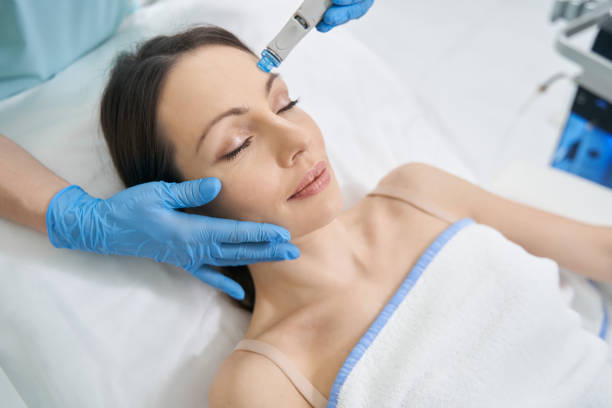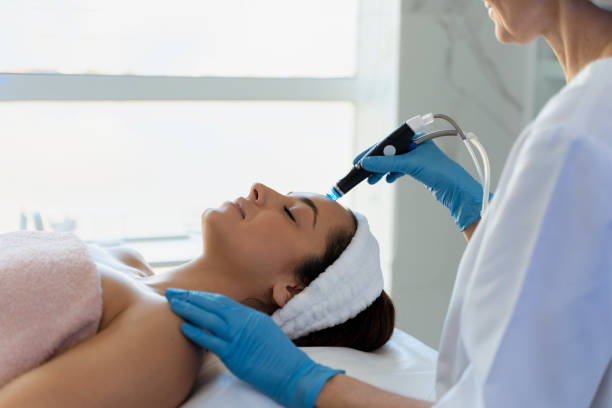Exploring the options for skin rejuvenation treatments can be confusing, similar to navigating a complex maze in search of glowing, healthy skin.
Two notable options are the HydraFacial and chemical peels, each offering a different method to address skin issues such as aging signs, acne, and hyperpigmentation.
HydraFacial employs a hydradermabrasion process for cleansing, extracting, and moisturizing, whereas chemical peels use acid solutions to remove dead skin and encourage new cell growth. Choosing the right one depends on your skin type, sensitivities, and beauty goals.
Read on to find out which option might be your key to achieving a luminous complexion.
Key Takeaways
- HydraFacial Is Ideal for People With Sensitive Skin Seeking Hydration Without Downtime
- Chemical Peels Provide a Deeper Intervention for Tackling Serious Skin Issues Like Hyperpigmentation and Deep Wrinkles
- Aftercare Is Crucial for Both Treatments, With HydraFacial Requiring Minimal Downtime and Chemical Peels Needing More Specific Care
- The Choice Between HydraFacial and Chemical Peel Depends on Individual Skin Concerns and Cosmetic Goals
- Regular Treatments May Be Necessary to Maintain the Benefits of Both HydraFacial and Chemical Peels
Understanding the Basics: HydraFacial vs. Chemical Peel

When considering facial rejuvenation, HydraFacial, and chemical peels stand out as two highly effective treatments.
Each offers a unique approach to achieving a glowing complexion.
HydraFacial, known for its gentleness, focuses on hydrating and nourishing the skin, making it an excellent option for those with sensitive skin seeking to avoid harsh procedures.
On the other hand, chemical peels dive deeper, using a solution of different acids to strip away older skin layers, thus encouraging new, healthier skin to come to the fore.
This method is particularly good for individuals looking to tackle more pronounced skin issues like hyperpigmentation or acne scars.
Understanding the key differences between these treatments empowers individuals to make an informed choice on which path may best suit their skin type and aesthetic goals.
Defining HydraFacial: A Gentle Approach to Skin Rejuvenation
HydraFacial stands out for its unique ability to combine cleansing, exfoliation, extraction, and hydration all in one gentle yet effective treatment. By infusing the skin with serums packed with antioxidants, peptides, and hyaluronic acid, it addresses a wide range of skin concerns without irritating. This makes it particularly appealing for people with sensitive skin who desire a radiant complexion without the discomfort or downtime associated with more invasive procedures.
Exploring Chemical Peels: Deep Exfoliation for Renewed Skin
Chemical peels go beneath the surface, offering a solution for those who yearn for profound change. By applying a mix of powerful acids, they remove dead skin cells and stimulate the growth of new, healthy skin. It’s a favored choice for people wrestling with stubborn skin conditions like melasma or deep-seated acne, eager for a smoother, more even complexion.
Key Differences Between the Two Treatments
HydraFacial and chemical peels take distinct pathways toward rejuvenating the skin. While HydraFacial opts for a gentler, more nourishing route by infusing the skin with vital hydration and nutrients, chemical peels adopt a more aggressive stance, utilizing acid solutions to peel away the outermost layer of the skin, fostering the emergence of new, healthier layers beneath. This fundamental difference in approach offers individuals a choice between a mild, soothing treatment and a potent, corrective therapy depending on their skin’s needs and their personal aesthetic goals.
Addressing Skin Concerns with Hydrafacial and Chemical Peels

Choosing between HydraFacial and chemical peels depends on understanding the skin concerns each treatment is best equipped to tackle.
HydraFacials cater primarily to those seeking enhanced hydration and relief from milder skin conditions, effectively nurturing a more vibrant and plump appearance.
In contrast, chemical peels are designed to penetrate the deeper layers of the skin, making them the go-to option for addressing more severe issues such as pronounced wrinkles, scars, and uneven skin tone.
This distinction allows individuals to tailor their approach to skin rejuvenation, matching the treatment to the nature and severity of their skin challenges.
HydraFacial: For Hydration and Mild Skin Issues
HydraFacial shines when it comes to rejuvenating skin that’s thirsty for moisture or dealing with mild issues like light acne, dullness, and large pores. It’s a superb choice for people wanting to perk up their skin’s hydration levels and achieve a dewy, healthy-looking glow without stepping into the territory of aggressive treatments.
Chemical Peels: Targeting Deeper Skin Layers for Major Concerns
Chemical peels offer a powerful solution for those battling with more significant skin concerns. By employing a blend of potent acids, they delve beneath the top layer of the dermis to reveal smoother, more evenly toned skin underneath. It’s the preferred method for individuals aiming to dramatically reduce the appearance of deep wrinkles, stubborn hyperpigmentation, and other complex skin conditions that require more intensive intervention.
The Procedure: What to Expect During Each Treatment

Deciding between a HydraFacial and a chemical peel often boils down to what one can expect during the treatment itself.
Each procedure has its unique steps that cater to different skin needs and goals.
A closer look at the step-by-step process of a HydraFacial session reveals a nurturing, multi-part approach focusing on cleansing, exfoliation, extraction, and hydration, all aimed at delivering a refreshed, radiant complexion with minimal discomfort.
Meanwhile, diving into what happens during a chemical peel uncovers a transformative process, where a specialized solution is applied to remove the outermost layers of skin, paving the way for revitalization and addressing deeper skin concerns more aggressively.
Understanding these procedures lifts the veil on how each treatment works to rejuvenate and restore the skin, guiding individuals toward making an informed decision that aligns with their cosmetic objectives.
Step-by-Step Process of a HydraFacial Session
A HydraFacial session begins with the practitioner carefully cleansing and then exfoliating the skin to remove any buildup of debris or dead skin cells. Following this, a special vortex extraction tool is used to gently suck out blackheads, oil, and impurities from pores, without causing the discomfort typically associated with manual extractions. Lastly, the skin is infused with a rich blend of serums that hydrate, protect, and nourish, leaving the patient’s complexion refreshed and glowing.
What Happens During a Chemical Peel?
During a chemical peel, the professional applies a tailored blend of acids to the patient’s skin, carefully chosen to target specific concerns. This solution works by dissolving the top layers of the skin, which can sound intense but is a controlled process designed to rejuvenate the skin by prompting the body’s natural healing process. As the old, damaged skin peels away over the following days, it reveals a smoother, more even-toned layer beneath, providing a noticeable improvement in the skin’s overall appearance.
Aftercare and Recovery: HydraFacial vs. Chemical Peel

The path to achieving and maintaining the desired outcomes heavily hinges on the post-treatment care unique to each procedure.
While HydraFacial boasts minimal to no downtime, allowing patients to return to their daily activities almost immediately, the meticulous aftercare required following a chemical peel is vital for promoting proper healing and maximizing the benefits of deeper exfoliation.
Let’s delve into the specifics of post-treatment care for both HydraFacial and chemical peel, highlighting the key steps individuals need to follow to ensure a smooth and effective healing process.
Post-Treatment Care for HydraFacial
After receiving a HydraFacial, patients find the aftercare process refreshingly straightforward. They are advised to continue with their usual skincare routine, incorporating gentle cleansers and moisturizers to keep the skin well-hydrated. Staying out of direct sunlight and applying a broad-spectrum sunscreen are also recommended to protect the newly rejuvenated skin from environmental damage and ensure lasting results.
Healing Process and Care After a Chemical Peel
After a chemical peel, the patient’s skin embarks on a transformation centered around rejuvenation and healing. This period requires diligent care: moisturizing with products recommended by the dermatologist, avoiding direct sun exposure, and refraining from picking at peeling skin to prevent scars and support a smooth recovery. Ensuring compliance with these guidelines fast-tracks the journey toward a revitalized appearance:
| Aftercare Step | Description | Duration |
|---|---|---|
| Moisturizing | Apply hydrating products to aid in skin recovery. | As recommended |
| Sun Protection | Avoid direct sunlight and use sunscreen. | Post-treatment indefinitely |
| Avoid Picking | Refrain from peeling or picking at the skin to prevent scars. | Until the skin fully heals |
Potential Side Effects and Risks

Every skin treatment comes with its own set of considerations, especially when it comes to potential side effects and risks.
While HydraFacial prides itself on being a gentle solution suitable for a variety of skin types, including those with sensitive skin, patients need to recognize its limits and the rare cases where complications may arise.
On the flip side, chemical peels, recognized for their deeper skin penetrating abilities, carry a higher risk profile, particularly for individuals with specific skin conditions or sensitivity to the acids used.
Balancing the safety of HydraFacial alongside understanding the risks associated with chemical peels equips individuals with the knowledge to proceed confidently with their chosen skin rejuvenation treatment.
Considering the Safety of HydraFacial
The safety of HydraFacial is one of its most compelling features, especially for those with sensitive skin. This gentle procedure is designed to minimize the risk of irritation and adverse reactions, offering a soothing alternative to more invasive skin treatments. As with any skin therapy, a detailed consultation with a skincare professional is recommended to address any personal concerns or conditions that could affect treatment outcomes.
| Risk Factor | HydraFacial Safety | Advised Action |
|---|---|---|
| Sensitive Skin | Low Risk of Irritation | Consult Before Treatment |
| Adverse Reactions | Uncommon | Immediate Professional Assessment |
Understanding the Risks Associated With Chemical Peels
Understanding the risks associated with chemical peels is critical for anyone considering this deeper form of skin rejuvenation: While offering significant improvements for issues like deep wrinkles and severe hyperpigmentation, chemical peels can lead to redness, peeling, and sensitivity as the skin heals. Patients need to follow their dermatologist’s guidance closely to mitigate these risks.
| Risk Factor | Description | Recommended Precaution |
|---|---|---|
| Skin Sensitivity | Increased post-treatment sensitivity | Use prescribed soothing creams |
| Redness and Peeling | Common side effects as skin rejuvenates | Apply moisturizer and avoid direct sunlight |
| Infection Risk | Possible if the skin is not cared for properly | Maintain cleanliness and follow aftercare meticulously |
Making the Right Choice for Your Skin Type and Goals

Deciding between HydraFacial and chemical peel treatments pivots on closely examining your skin’s specific needs and the goals you wish to achieve.
While HydraFacial offers a soothing path to enhanced hydration, ideal for those with a sensitive or parched complexion looking for an immediate glow, a chemical peel steps in as a potent ally against more stubborn, deep-rooted skin problems.
This demands a thoughtful evaluation of your skin’s condition and what you aim to correct or improve.
Whether it’s gentle nourishment or an aggressive combating of aging signs and scars you’re after, understanding when each treatment becomes the right choice is crucial on your journey toward skin perfection.
Assessing Your Skin’s Needs: When to Choose HydraFacial
Choosing HydraFacial becomes the path to take when someone’s skin craves hydration without the harshness of rigorous treatments: It’s designed for those whose skin is more sensitive or could benefit from moisture without downtime. If your skin goals include achieving a refreshed look, diminishing the appearance of pores, and enhancing your complexion’s hydration without the intensive peeling process, HydraFacial stands out as the gentle yet effective solution.
| Skin Type | Primary Need | Why Choose HydraFacial? |
|---|---|---|
| Sensitive | Hydration | Less irritation and no downtime |
| Dry | Moisture | Deeply hydrates and nourishes |
| Normal | Rejuvenation | Gives a radiant, healthy look |
When a Chemical Peel Might Be the Better Option
Choosing a chemical peel could be the best option for those looking to address more persistent and severe skin issues. If you’re aiming to lessen the appearance of pronounced hyperpigmentation, age spots, or deep wrinkles, and your skin can tolerate the robust nature of a chemical peel, this approach provides a potent means for significant rejuvenation. It can lead to a notable enhancement in the skin’s texture and overall tone.
| Skin Concern | Desired Outcome | Why Choose a Chemical Peel? |
|---|---|---|
| Significant Hyperpigmentation | Dramatic Improvement | Targets deeper layers for a brighter complexion |
| Deep-Set Wrinkles | Smoother Skin | Promotes collagen production to fill in wrinkles |
| Age Spots | Even Skin Tone | Removes damaged outer layers to reduce spots |
Conclusion
Choosing the best skin treatment between HydraFacial and chemical peels hinges on understanding your specific skin needs and cosmetic goals.
HydraFacial offers a gentle, hydrating solution ideal for sensitive, dry, or normal skin that seeks rejuvenation without the harshness of more invasive treatments, making it perfect for those desiring a refreshed look with no downtime.
Conversely, chemical peels provide a more intensive solution, targeting deeper layers of the skin to address significant hyperpigmentation, deep-set wrinkles, and age spots, suitable for those whose skin can tolerate a more aggressive approach for profound rejuvenation.
Assessing your skin’s condition and what you aim to improve is crucial in making an informed decision, ensuring that you choose the treatment that aligns with your desired outcomes for a healthier, more radiant complexion.



